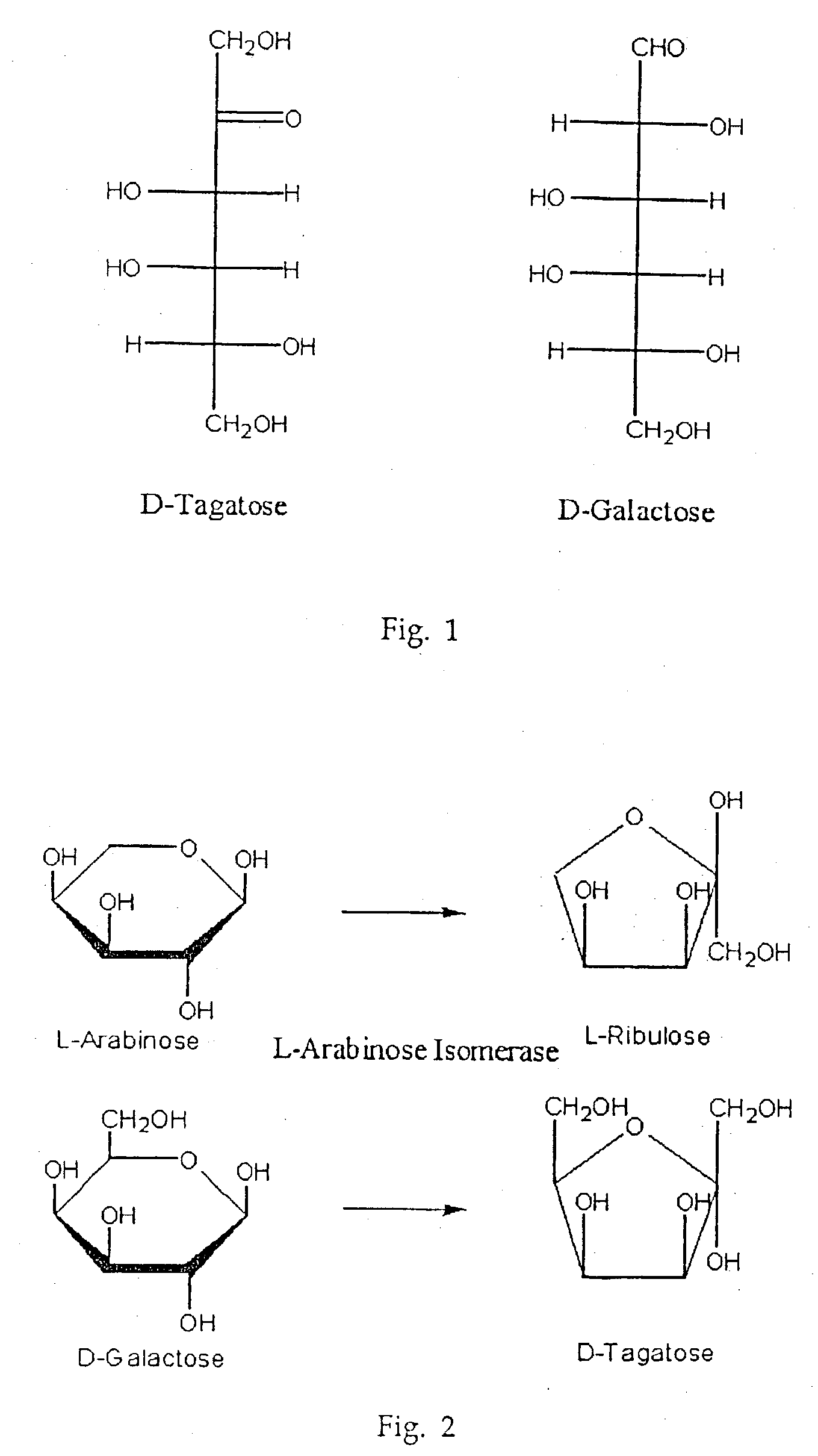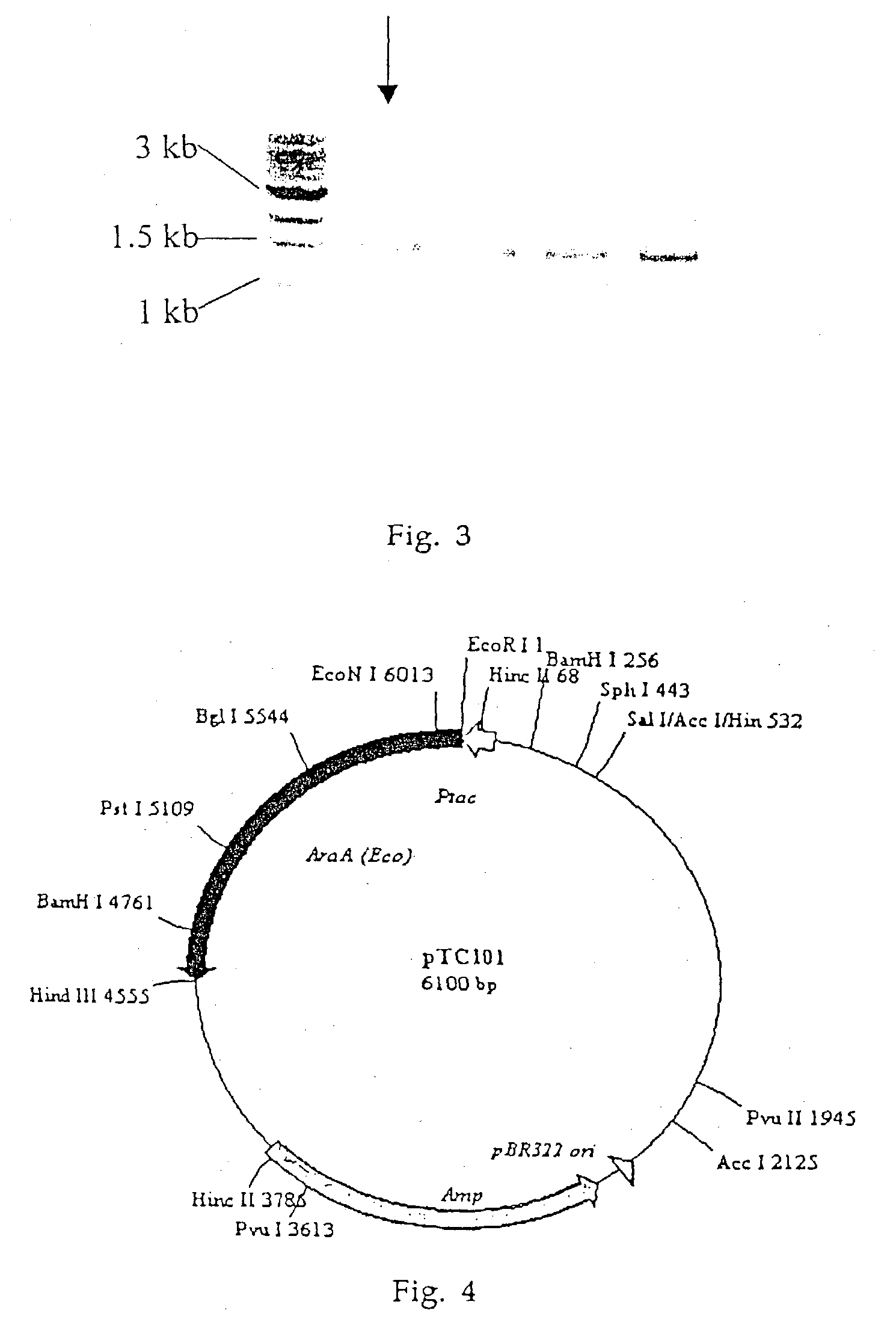Biological tagatose production by recombinant Escherichia coli
a technology of escherichia coli and tagatose, which is applied in the preparation of sugar derivatives, enzymes, sugar derivatives, etc., can solve the problems of inability to produce e.coli tagatose, disadvantageous high temperature and high pressure, and inability to achieve laxative effect, etc., to achieve the effect of easy control of the metabolism of e.coli
- Summary
- Abstract
- Description
- Claims
- Application Information
AI Technical Summary
Benefits of technology
Problems solved by technology
Method used
Image
Examples
example 2
[0035] Tagatose Production by the Whole Cell of Recombinant E.coli
[0036] The E.coli JM105 / pTC100 was pre-cultured in the LB-medium, and then transferred into main culture medium. The main medium contained following components (Table 1).
3 TABLE 1 Yeast Galactose KH.sub.2PO.sub.4 Na.sub.2HPO.sub.4 NH.sub.4Cl extract Concentration 20 6 3 1 10 (g / L)
[0037] Single colony of E.coli JM105 / pTC101 was inoculated into 3 ml LB medium, and overnight cultured at 37.degree. C. aerobically. The preculture was transferred into 250 ml Erlenmyer flask containing 50 ml of the IPTG (1 mM) in LB medium. When biomass reached absorbance 1.0 at 600 nm, cells were collected by centrifuge and inoculated into 3 ml of main medium. The main culture was maintained for 96 hrs at 37.degree. C., 250 rpm shaking incubator. Finally, 0.86 g / L of tagatose was produced from recombinant E.coli whole cell, where no tagatose was found in the wild type E.coli. (Table 2).
4 TABLE 2 Tagatose Produced Galactose Remained Strain (...
example 3
[0040] Tagatose Production by Crude Extract of Recombinant E.coli Expressing AraA
[0041] A crude extract of AraA from E.coli was prepared as follows. Actively growing cells (50 ml, O.D. 600 2.0) in the LB-medium containing IPTG (1 mM) were prepared by centrifugation (7,000 g, 4.degree. C.). The cell pellet was resuspended in a 5 ml of phosphate buffer (50 mM, pH 7.0). The cells were disrupted by using an ultrasonic processor (50-watt Model, Cole-Parmer) at 40% output for 10 min in the ice. The crude arabinose isomerase solution was obtained after removal of cell-debris by centrifugation of the cell-disrupted suspension at 7,000 g and 4.degree. C. for 15 min. A crude extract of AraA was fractionated by ammonium sulfate salting out at 40-60% saturation, and pelleted by centrifuge (10,000g, 4.degree. C.). The pellet was further dialyzed overnight at 4.degree. C. using a cellulose membrane tubing (MWCO: 12,000, Sigma, USA) to remove ammonium sulfate. Column chromatography was further car...
example 4
[0043] Tagatose Production by Immobilized Enzyme of L-Arabinose Isomerase
[0044] The purified L-arabinose isomerase as above was immobilized by a Calcium-Alginate. Briefly, 10 ml of the purified enzyme solution (381 U / ml) was mixed with the 10 ml of 0.15 M NaCl containing high-viscosity alginate gel (2.4%), then slowly expressed through a needle (id=0.3 mm) in a dropwise fashion into a 100 mM CaCl.sub.2 solution. After instantaneous gelation, the beads were allowed to polymerize further for the period of 10 min in the CaCl.sub.2 solution. The beads were added into 50 ml of galactose (100 g / L) dissolved in 50 mM phosphate buffer (pH=7.0). The conversion was performed for 24 hrs at 35.degree. C. incubator. Table 3 shows the result.
5 TABLE 3 Free Enzyme Immobilized Enzyme Tagatose Production 21.2 12.3 (g / L)
[0045] As shown in the Table 3, free enzyme solution gave 21.2 g / L where immobilized one gave 12.3 g / L of tagatose. This result indicates there is a mass transfer bottleneck in the ca...
PUM
| Property | Measurement | Unit |
|---|---|---|
| pH | aaaaa | aaaaa |
| concentration | aaaaa | aaaaa |
| temperature | aaaaa | aaaaa |
Abstract
Description
Claims
Application Information
 Login to View More
Login to View More - R&D
- Intellectual Property
- Life Sciences
- Materials
- Tech Scout
- Unparalleled Data Quality
- Higher Quality Content
- 60% Fewer Hallucinations
Browse by: Latest US Patents, China's latest patents, Technical Efficacy Thesaurus, Application Domain, Technology Topic, Popular Technical Reports.
© 2025 PatSnap. All rights reserved.Legal|Privacy policy|Modern Slavery Act Transparency Statement|Sitemap|About US| Contact US: help@patsnap.com



